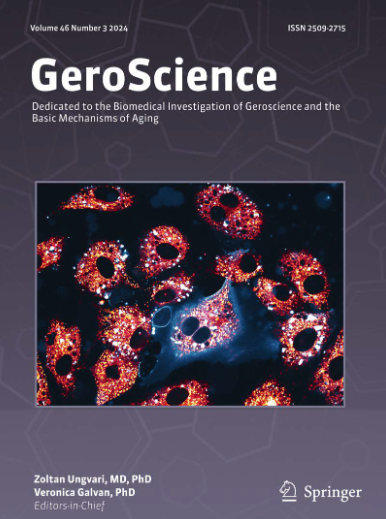The aging choroid plexus and its relationship with gut dysbiosis and Klotho decline: possible intervention strategies.
IF 5.3
2区 医学
Q1 GERIATRICS & GERONTOLOGY
引用次数: 0
Abstract
The choroid plexus (ChP) is a complex ventricular structure that forms a semi-permeable barrier between the blood and cerebrospinal fluid (CSF). It is responsible for CSF secretion and clearance, contains macrophages, and is one of the few sites within the central nervous system (CNS) where T cells are present. Additionally, the ChP plays a role in detecting peripheral inflammation, which leads to the modulation of its epithelial cell function. Despite its critical importance in maintaining brain homeostasis, the ChP is often overlooked, particularly concerning the changes it undergoes with aging, such as reduced barrier function, impaired CSF production, and altered immunosurveillance. These age-related alterations may contribute to several harmful effects, including neuroinflammation and oxidative damage, potentially predisposing individuals to neurodegenerative conditions. Although knowledge is still limited, gut dysbiosis and decreased Klotho levels-of which the ChP is one of the main sources-appear to be significant contributors to ChP impairments. This narrative review will examine the impact of age-related gut dysbiosis on the CNS, focusing on the ChP, and explore the effects of reduced Klotho levels in this brain structure. We will also propose the hypothesis that combining the administration of probiotics capable of restoring gut microbiota eubiosis with gene therapy to upregulate Klotho in the ChP could help preserve the structural and functional integrity of the aging brain. Finally, we will provide a technical overview to ensure that vectors encoding Klotho cDNA achieve maximum specificity for the ChP, thereby avoiding off-target effects.脉络膜丛老化及其与肠道生态失调和Klotho衰退的关系:可能的干预策略。
脉络膜丛(ChP)是一个复杂的心室结构,在血液和脑脊液(CSF)之间形成半透性屏障。它负责脑脊液的分泌和清除,含有巨噬细胞,是中枢神经系统(CNS)中少数存在T细胞的部位之一。此外,ChP在检测外周炎症中起作用,这导致其上皮细胞功能的调节。尽管ChP在维持脑内稳态中起着至关重要的作用,但它经常被忽视,特别是随着年龄的增长,它所经历的变化,如屏障功能降低、脑脊液产生受损和免疫监视改变。这些与年龄相关的改变可能会导致一些有害的影响,包括神经炎症和氧化损伤,潜在地使个体易患神经退行性疾病。虽然我们的知识仍然有限,但肠道生态失调和Klotho水平下降(ChP是主要来源之一)似乎是导致ChP损伤的重要因素。这篇叙述性综述将研究与年龄相关的肠道生态失调对中枢神经系统的影响,重点是ChP,并探讨Klotho水平降低对该大脑结构的影响。我们还将提出一种假设,即将能够恢复肠道微生物群益生的益生菌与基因治疗相结合,以上调ChP中的Klotho,有助于保持老化大脑的结构和功能完整性。最后,我们将提供技术概述,以确保编码Klotho cDNA的载体对ChP达到最大的特异性,从而避免脱靶效应。
本文章由计算机程序翻译,如有差异,请以英文原文为准。
求助全文
约1分钟内获得全文
求助全文
来源期刊

GeroScience
Medicine-Complementary and Alternative Medicine
CiteScore
10.50
自引率
5.40%
发文量
182
期刊介绍:
GeroScience is a bi-monthly, international, peer-reviewed journal that publishes articles related to research in the biology of aging and research on biomedical applications that impact aging. The scope of articles to be considered include evolutionary biology, biophysics, genetics, genomics, proteomics, molecular biology, cell biology, biochemistry, endocrinology, immunology, physiology, pharmacology, neuroscience, and psychology.
 求助内容:
求助内容: 应助结果提醒方式:
应助结果提醒方式:


